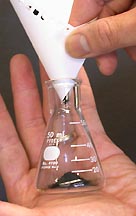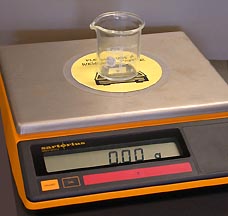
 |
ROTOVAP |
 1) If you are going to be weighing solids onto a weighing paper, first take the weighing paper, fold it in half in one direction, open it up and fold it in half in the other direction. This will mark the weighing paper in four equal quadrants. Open up the weighing paper so that the folds are away from you. The centre portion of the paper will now be lower than the outer edges and thus you will be less likely to spill some sample off the paper. |
|
 |
 |
 |
| However it is not necessary to know this weight. Press the “TARE” button (which on some balances might be the “T” button or “REZERO” button) and the balance will now record this as a “ZERO” weight (or very close to “ZERO”). | ||
3) Using a spatula or scoopula, add the solid sample unto the weighing paper until the balance registers the amount that you need to weigh. NOTE: if you are told to weigh out “approximately X grams” of a sample, that does not mean that you have to weigh “X.00 grams”. That usually means that you would have to get within 10% of this weight – either below or above – but you must record the exact weight you get to 2 decimal places. For example, say that you are asked to weigh 1 gram of a solid. Any weight between 0.9 to 1.10 grams would be okay as long as you recorded the final weight to 2 decimals. |
 |
 |
 |
4) Transfer the solid into the desired container by folding the corners at 2 ends of the weighing paper to form a cone at one end. Insert the cone end into the container and let the solid slide in (tap the paper cone lightly if necessary to dislodge any solid that might stick). Press the “TARE” button again so that the balance pan records a “ZERO” weight. |  |
In most cases if you have to weigh a liquid that is a reagent for a reaction, you would be better off converting this weight to a volume, using the density of the liquid at room temperature. However if the product of a reaction you are doing is a liquid, then you should first weigh the container that you are going to collect the liquid in. This container must be clean and dry and must be something that can be corked (ie. a test tube or Erlenmeyer flask, NOT a beaker). The empty container plus the cork is weighed before the product is collected. |
 |
 |
 |
NOTE: if you are using a test tube to collect the liquid sample in, you will not want the sample to touch the cork on the end of the tube. Therefore when you weigh the test tube plus cork, either empty or full of sample, this must be weighed standing up supported by a beaker. If you wish, the beaker can be “tared” first to record a “ZERO” weight before you weigh the tube in it. |
NOTE: when you are attempting to “TARE” a container, if the balance does not give you a “zero” reading, it is probably because that container is too heavy for that balance. Please use a “lighter” or “smaller” container. Put the corked test tube in the “tared” beaker and record this weight. | Weigh the corked test tube with the liquid sample in it and record this weight to 2 decimals. Subtract the weight of the empty corked test tube to obtain the weight of the liquid sample. |